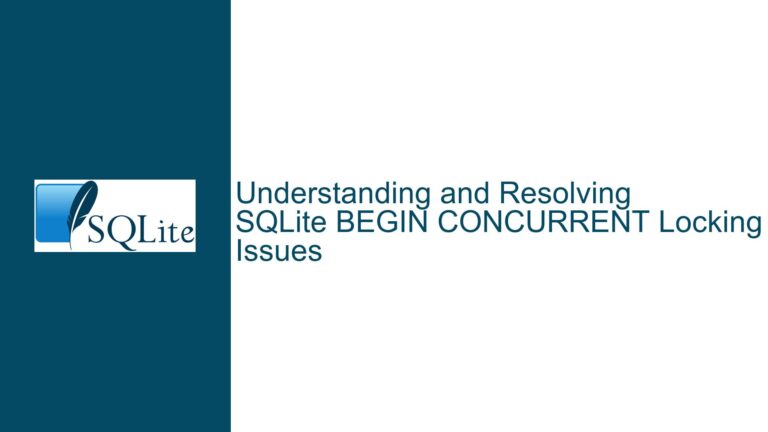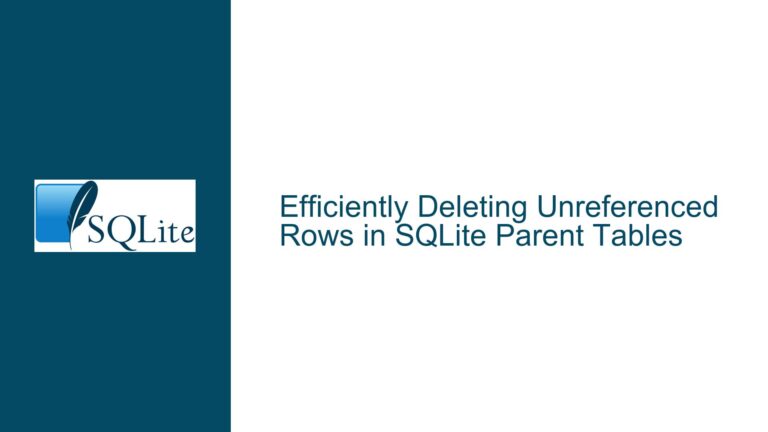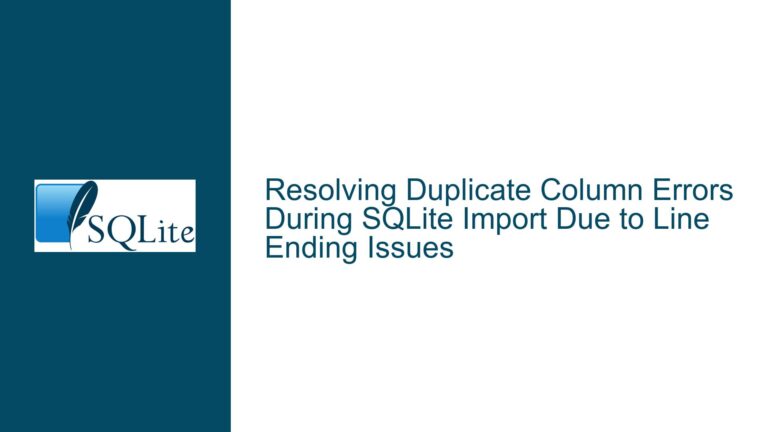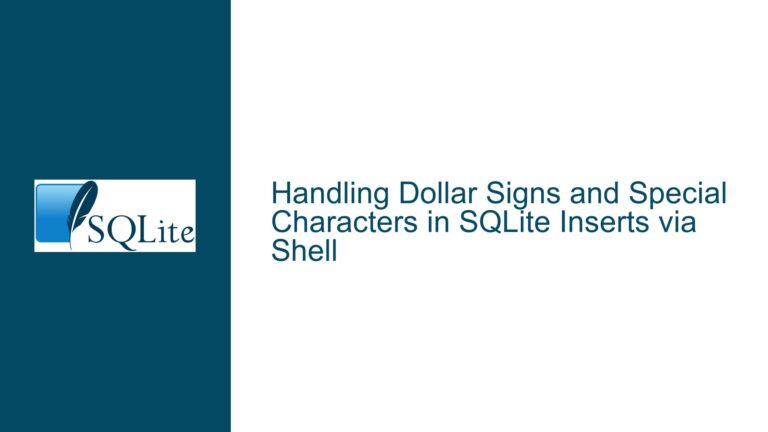Iterating and Updating SQLite Table Rows Safely with PHP
Iterating Through and Updating Rows in SQLite Using PHP
When working with SQLite databases in a PHP environment, a common task is iterating through rows in a table and updating specific fields based on certain criteria. This process, while seemingly straightforward, involves several critical considerations to ensure both functionality and security. The primary goal is to update values in a column, such as progressiveID in a table named myTable, where the values exceed a specified threshold x. However, the approach must be carefully designed to avoid common pitfalls, such as SQL injection vulnerabilities, and to ensure efficient execution.
The core challenge lies in constructing an SQL query that dynamically updates rows based on a condition while safeguarding against malicious input. This requires a deep understanding of SQLite’s capabilities, PHP’s database interaction methods, and best practices for secure database operations. Below, we will explore the issue in detail, identify potential causes of problems, and provide a comprehensive guide to implementing a secure and efficient solution.
Risks of Inline Variable Expansion and SQL Injection Vulnerabilities
One of the most critical aspects of database interaction is ensuring that user input or external data does not compromise the integrity of the database. Inline variable expansion in SQL queries, such as directly embedding PHP variables into SQL strings, is a common but dangerous practice. This approach can lead to SQL injection attacks, where malicious users manipulate the query to execute unintended commands or access unauthorized data.
For example, consider the following insecure PHP code snippet:
$db->exec("UPDATE myTable SET progressiveID = $vId_new WHERE progressiveID > $x");
In this case, if $vId_new or $x are derived from user input, an attacker could inject malicious SQL code. For instance, if $x is set to "1; DROP TABLE myTable; --", the resulting query would not only update rows but also delete the entire table. This underscores the importance of using parameterized queries or prepared statements, which separate SQL code from data, thereby preventing injection attacks.
Another risk associated with inline variable expansion is the potential for syntax errors or unexpected behavior due to improper escaping of special characters. For example, if $vId_new contains a single quote, the query could fail or produce incorrect results. Parameterized queries mitigate this risk by automatically handling special characters and ensuring that data is treated as literal values rather than executable code.
Implementing Parameterized Queries and Prepared Statements in PHP
To address the risks outlined above, PHP provides several mechanisms for safely interacting with SQLite databases. The most robust approach is to use prepared statements with bound parameters. Prepared statements allow you to define an SQL query with placeholders for dynamic values, which are then securely bound to the query at execution time. This ensures that user input is treated as data rather than executable code, effectively preventing SQL injection attacks.
PHP’s PDO (PHP Data Objects) extension is a powerful tool for database interaction, offering a consistent interface for accessing various database systems, including SQLite. Below is an example of how to use PDO to safely update rows in myTable based on the value of progressiveID:
// Establish a connection to the SQLite database
$db = new PDO('sqlite:/path/to/database.sqlite');
// Define the SQL query with placeholders for dynamic values
$query = "UPDATE myTable SET progressiveID = :vId_new WHERE progressiveID > :x";
// Prepare the statement
$stmt = $db->prepare($query);
// Bind the parameters to the placeholders
$stmt->bindValue(':vId_new', $vId_new, PDO::PARAM_INT);
$stmt->bindValue(':x', $x, PDO::PARAM_INT);
// Execute the statement
$stmt->execute();
In this example, :vId_new and :x are named placeholders that represent the dynamic values in the query. The bindValue method securely binds the PHP variables $vId_new and $x to these placeholders, ensuring that they are treated as literal values. The PDO::PARAM_INT parameter specifies that the values should be treated as integers, further enhancing security and preventing type-related issues.
Another approach is to use positional placeholders, where each placeholder is represented by a question mark (?). The parameters are then bound in the order they appear in the query:
// Define the SQL query with positional placeholders
$query = "UPDATE myTable SET progressiveID = ? WHERE progressiveID > ?";
// Prepare the statement
$stmt = $db->prepare($query);
// Bind the parameters to the placeholders
$stmt->bindValue(1, $vId_new, PDO::PARAM_INT);
$stmt->bindValue(2, $x, PDO::PARAM_INT);
// Execute the statement
$stmt->execute();
Both approaches are equally valid, and the choice between named and positional placeholders often comes down to personal preference or project requirements. However, named placeholders can improve code readability, especially in queries with many parameters.
Optimizing Performance and Ensuring Data Integrity
While security is paramount, performance and data integrity are also critical considerations when updating rows in a database. Large-scale updates can be resource-intensive, particularly if the table contains a significant number of rows or if the update operation is part of a larger transaction. Below are some strategies for optimizing performance and ensuring data integrity:
Batch Updates: Instead of updating rows one at a time, consider batching multiple updates into a single transaction. This reduces the overhead associated with committing each individual update and can significantly improve performance. For example:
$db->beginTransaction(); try { $query = "UPDATE myTable SET progressiveID = :vId_new WHERE progressiveID > :x"; $stmt = $db->prepare($query); $stmt->bindValue(':vId_new', $vId_new, PDO::PARAM_INT); $stmt->bindValue(':x', $x, PDO::PARAM_INT); $stmt->execute(); $db->commit(); } catch (Exception $e) { $db->rollBack(); throw $e; }In this example, the
beginTransactionandcommitmethods ensure that all updates are treated as a single atomic operation. If an error occurs, therollBackmethod undoes any changes made during the transaction, preserving data integrity.Indexing: Ensure that the
progressiveIDcolumn is indexed, as this can dramatically improve the performance of queries that filter or sort based on this column. Without an index, SQLite must perform a full table scan, which can be slow for large tables. You can create an index using the following SQL command:CREATE INDEX idx_progressiveID ON myTable(progressiveID);Concurrency Control: If multiple users or processes are accessing the database simultaneously, consider implementing concurrency control mechanisms to prevent conflicts. SQLite supports various locking modes, such as
BEGIN IMMEDIATEorBEGIN EXCLUSIVE, which can help manage concurrent access. Additionally, using transactions as shown above can help ensure that updates are applied consistently.Error Handling: Robust error handling is essential for maintaining data integrity and providing a smooth user experience. In the example above, the
try-catchblock ensures that any exceptions thrown during the update process are caught and handled appropriately. This prevents the application from crashing and allows you to log errors or notify users as needed.Testing and Validation: Before deploying updates to a production environment, thoroughly test the code in a controlled setting. This includes validating input data, testing edge cases, and simulating high-load scenarios to ensure that the system performs as expected. Automated testing frameworks, such as PHPUnit, can be invaluable for this purpose.
By combining these strategies, you can create a secure, efficient, and reliable solution for iterating through and updating rows in an SQLite database using PHP. This approach not only mitigates the risk of SQL injection but also ensures that the database remains performant and consistent, even under demanding conditions.






